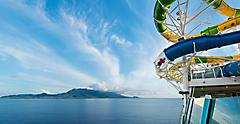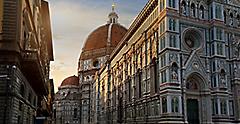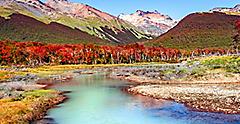By Hayley Simpson | Published on October 26, 2023
Royal Caribbean has taken expedition cruises countless steps further with the Ultimate World Cruise onboard the fleet-favorite cruise ship, Serenade of the Seas. This epic round-the-world journey is made up of four different segments that span 60 or more nights each and visit different corners of the world. You can also go on the full world cruise itinerary — a travel adventure continuing across a whopping 274 nights with stops in over 60 countries on all seven continents. If you need to figure out how to pick a world cruise segment, the quiz will help you find the perfect vacation based on your personality and interests.
From outdoor adventures in hard-to-reach places to full immersion in some of the world's oldest cultural capitals, each leg of the trip offers something for everyone. Use this guide to help you determine how to choose the best cruise segment for you.
Popular and Famous Wildlife in Australia
One of the most famous stars of Australian wildlife is the kangaroo, which has pride of place on the Australian coat of arms. The kangaroo is the most popular making is a common animal to see in Australia. In fact, more kangaroos call Australia home than people, and they can be found in most rural areas country-wide. When looking for things to do in Australia, simply head out of the city and it won't be long until you can start spotting kangaroos.
Kangaroos are the world's largest marsupial (an animal that carries its young in a pouch), and they can hop at an incredible 37 miles per hour. There are several different kangaroo species — as well as their smaller cousins, called wallabies. They're most active between dusk and dawn when they go searching for food. If you spot a kangaroo in the wild, it's best to simply admire them from afar. They may look cuddly, but the kangaroo's large feet deliver one of the most powerful kicks on the planet.
The other magnificent Australian animal on the country's coat of arms is the emu. It's the world's second-largest bird, following the ostrich (a distant but similar-looking relative). You'll find wild emus everywhere in Australia except Tasmania. They prefer woodland to tropical rainforest and can be spotted from Western Australia to the New South Wales Snowy Mountains.
One of the most common, yet famous, Australian animals abroad is undoubtedly the koala. Some would say they have an enviable existence, spending their lives eating eucalyptus leaves and sleeping for up to 20 hours per day. However, they are considered a vulnerable species and are exclusively found in select East Coast destinations. To see a wild koala, head to Phillip Island, the Great Ocean Road, Raymond Island or Magnetic Island.
The koala's closest relation is the wombat, an expert burrower with short yet powerful legs. Watching these golden-retriever-sized balls of fur waddle across the Australian wilderness is an unforgettable sight. When searching for the nocturnal koala on your vacation, you’ll primarily find them in southeastern Australia and Tasmania in places like Wilsons Promontory National Park, Kangaroo Valley, and Maria Island.
Another unique animal, the echidna, will most likely appear slowly waddling its way across the rural roads as you travel on your Australian vacation. This spiky critter is the country's most widespread native mammal and one of the world's only egg-laying mammals, along with the platypus. Keep an eye out for echidnas in all landscapes, including deserts, rainforests and mountains. They're also referred to as a "spiny anteater" thanks to their insect-heavy diet.
Finally, you can't talk about wildlife in Australia without mentioning the dingo. This wild Australian dog species is listed as vulnerable to extinction. While they can be found across mainland Australia in desert, grassland and rainforest, a large population calls K'gari (Fraser Island) home. It's important to note that dingoes are Australia's largest terrestrial carnivore, so don't approach them.
Unique Australian Animal Facts as You Travel on Vacation
Kangaroos and koalas don't even scratch the surface when it comes to Australia's outlandish animal inhabitants. If you venture to Far North rainforest region in Queensland, you might spot a southern cassowary, which is essentially a modern-day dinosaur with deadly claws. It's no wonder it's described as the world's most dangerous bird. While you may not want to be approached by this flightless blue-faced bird in the wild, the species is critical to the survival of rainforests thanks to its role in transporting seeds.
There's nothing devilish about Tasmanian devils. This endangered species with a spotted coat is only found in Tasmania and has a vital role in the state's ecosystem. These small but voracious predators have helped to control introduced animals that eat native wildlife, and they've increased the survival rates of other native animals.
Another devil indigenous to Australia is the thorny devil. These spiky lizards are full of surprises. First, they have a fake second head on the back of their necks to repel predators, and they can change their appearance to camouflage with their surroundings. They drink water by rubbing their spikes against dew-covered grass, sending the water along the ridges directly into their mouths. One of the most fascinating Australian wildlife facts is that their diet is also exclusively black ants — up to 1,000 at every meal!
When in the woodlands of eastern Australia searching for wildlife, don't forget to look up — though you may hear the laughing kookaburra — one of the most unique Australian animals — before you see it. These large brown birds with a light blue patch on their wings are impressive looking, but it's their call that will make a lasting impression. The laughing kookaburra's cackle is often mistaken for a monkey, as the bird elicits a symphony of belly laughs, chuckles, and hoots in a variety of pitch and volume.
Finally, amid all Australia's dangerous and flashy animals, there's the quokka. The only place to encounter these sleepy, furry critters is on Rottnest Island, off the coast of Perth. They are part of the kangaroo and wallaby family (but smaller), and around 10,000 quokkas reside on the island today. The herbivores are mostly active at night, so if you want to get a selfie with one, the best time is around dusk or dawn. Be patient, let the quokka approach you, and do not feed or touch the cuddly creatures, no matter how cute they are.
If your trip to Australia includes a cruise from Sydney, Brisbane, Melbourne, or any other local ports sailing out of this beautiful land, be sure to make time to see lots of Australian wildlife on land as week as at sea. There's a unique animal experience waiting for you in magnificent Australia, from spotting a cassowary near Cairns to witnessing a wombat wobble across the Tasmanian wilderness.










